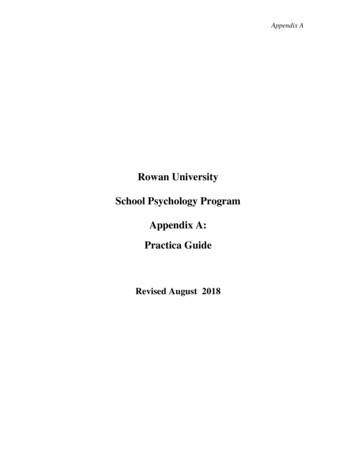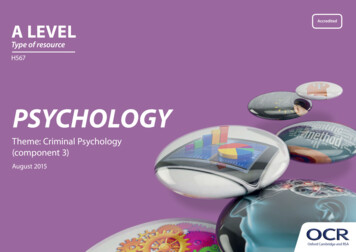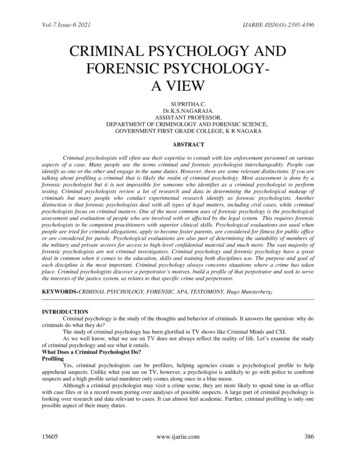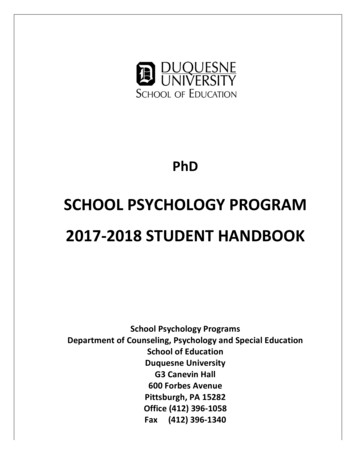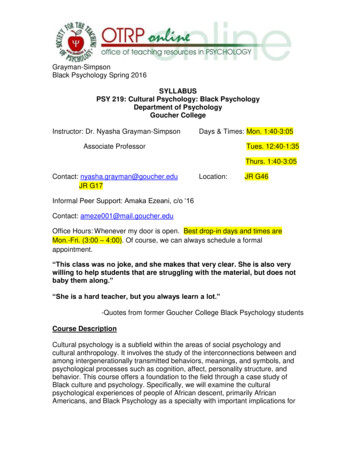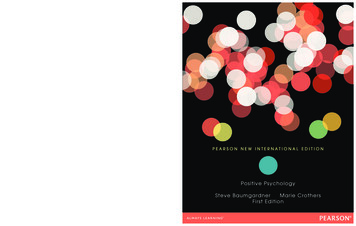
Transcription
th44 AnnualPsychology ResearchConferenceFull ProgramRowan UniversityApril 19, 2018Eynon BallroomChamberlain Student Center
About the ConferenceThe Rowan University Psychology Department's Annual Research Conference hasbeen an ongoing tradition for 43 years. Its intent is to allow students from both ourundergraduate and graduate programs the opportunity to present their researchfindings in a professional context. This conference offers students an excellentopportunity to develop their skills and gain experiences that will foster theirprofessional development. Most importantly, the conference allows students toshowcase the results of the psychological research they have been doing over thecourse of the past academic year.Psychology Department Mission StatementThe mission of the Psychology Department, as part of the College of Science& Mathematics at Rowan University, is to provide a high-quality education toundergraduate and graduate students, engage in cutting-edge research in a variety ofdisciplines and sub disciplines within psychology, and to provide services to childrenand their families in the South Jersey region. To achieve our mission, the departmentoffers two undergraduate degree programs: Bachelor of Arts in Psychology (33credits) and a Bachelor of Science in Psychological Science (60 credits). We also offera Concentration in Neuroscience in conjunction with Biological Sciences as well as aSpecialization in Behavioral Services for Children and their Families. At the graduatelevel, we offer a Ph.D. in Clinical Psychology and three Master of Arts degrees inApplied Behavior Analysis, Clinical Mental Health Counseling, and SchoolPsychology. Students in our department have the opportunity to work with facultymembers on novel and innovative research across the diverse subfields withinpsychology as well as being placed in community agencies and businesses toexperience first-hand how psychological science is applied to practice.Our StudentsWe currently serve approximately 1250 undergraduate majors, 100 minors, and 60graduate students. Our graduates are employed in a variety of professions. Some ofour recent graduates were employed by the following organizations: AT&T, Bancroft,Foster McKay, Maxim Behavior Services, New Behavior Network, and Twin Oaks.Our graduates have also attended a variety of graduate schools to earn degrees inSocial Work, Occupational/Physical Therapy, Experimental Psychology, ClinicalPsychology, Mental Health Counseling, School Counseling, and Applied BehaviorAnalysis. Also, some of our recent graduates have attended the following graduateschools: Bowling Green State University, Drexel University, Kean University, KentState University, Montclair State University, Rowan University, Rutgers University,Stockton College, The College of New Jersey, University of Delaware, and Universityof Idaho.
Conference Schedule9:00-10:00am: Oral PresentationsA Functional Assessment for Smoking Treatment RecommendationsConnor Burrows, Jesse Dallery, PhD, Sun Jung Kim, PhD, & Bethany Raiff, PhDFaculty Advisor: Dr. Bethany RaiffExamining the Relationship Between Childhood SES and Current Health Behaviors and Mental Health SymptomsErin Ryan & Tom Dinzeo, PhDFaculty Advisor: Dr. Tom DinzeoA Longitudinal Study of Mindfulness and Social Problem Solving in Predicting DepressionSean Martin, Kara Webb, Juliana D’Onofrio, MA, Krista Herbert, MA, & Jim A. Haugh, Ph.D.Faculty Advisor: Dr. Jim HaughAcademic Success and Risk Factors for Disease in a College SampleBenjamin Dunham, Emmanuel Alvarez & Lisa C. Abrams, PhDFaculty Advisor: Dr. Lisa AbramsDoes Dispositional Mindfulness Correlate with Blood Pressure Consistently Across Demographics?Baseline Analyses from the Serenity StudyGabrielle Chin, A.B, Jeffrey Greeson, Ph.D, Vanessa Anyanso, B.A, Jonathan Reda, B.S, Mary Keenan, B.A,Devin Barney, B.A, Rosa Heryak, B.A, Megan Strowger, M.A, Monica Fallon, M.A, Joel Hughes, Ph.D, &David Fresco, Ph.D,Faculty Advisor: Dr. Jeff Greeson10:00-11:15am: Oral PresentationsEffectiveness of Mobile Applications for Managing DepressionJane Akeret, Juliana D’Onofrio, M.A., Krista Herbert, M.A., & Jim A. Haugh, Ph.D.Faculty Advisor: Dr. Jim HaughOnline Community Reinforcement and Family Training (CRAFT) for Smoking Treatment EntryConnor Burrows, Jessica Nastasi, Samantha Sterner, & Bethany Raiff, Ph.D.Faculty Advisor: Dr. Bethany RaiffUse of Information and Communication Technologies and Mental Health: Relationship to Symptoms of Schizotypy,Anxiety, and DepressionDevin Massaro M.A. & Tom Dinzeo PhD.Faculty Advisor: Dr. Tom DinzeoDoes Positive Affect Moderate Sleep Quality in Schizotypy and Hypomania?Manny Alvarez & Tom Dinzeo, Ph.D.Faculty Advisor: Dr. Tom DinzeoVisual versus Verbal Declarative Memory: A Comparison Between the BVMT and the CVLTS. Emrani, V. J. Wasserman, S. Higgins, K. D. Garrett, R. Swenson, & D. J. LibonFaculty Advisor: Dr. David Libon
Visual Serial List Learning in Statistically-Determined Mild Cognitive ImpairmentVictor Wasserman, M.S., Sheina Emrani, B.S., Kelly Davis Garrett, PhD, Catherine C. Price, PhD, Melissa,Lamar, PhD, Rod Swenson, PhD, & David J. Libon, PhDFaculty Advisor: Dr. David Libon11:15am-12:00pm: Poster Session I12:00-1:00pm: Oral PresentationsUsing a Family Medical Tree as a Predictor of Physical Activity: An Undergraduate SamplePierre A. Leon, M.A., Alex Jaffe, B.A., Breanna Willis, Rebecca Ashmore, Anthony Eldridge, Larissa Thiele,Samantha Weiss, Trina Ganguly, B.A., Dustin Fife, Ph.D., & Georita M. Frierson, Ph.D.Faculty Advisor: Dr. Georita FriersonProject PAN: Relationship Between Physical Health and Non-Suicidal Self InjuryAlex Jaffe B.A, Pierre A Leon M.S., Anthony Eldridge B.A., Samantha Weiss, Larissa Thiele,Rebecca Ashmore, & Georita M Frierson Ph.D.Faculty Advisor: Dr. Georita FriersonUsing a Behavioral Economic Measure to Assess the Reinforcing Properties of Non-Medical Use of PrescriptionStimulant Medication Among College StudentsMatthew J. Dwyer, Jovanna Beardsworth, Alicia Burke, Connor Burrows, ClaudiaDrossel, &Kimberly C. Kirby, PhDFaculty Advisor: Dr. Kim KirbyIdentifying Factors Influencing Men’s Risk for Sexual Violence PerpetrationEbru Yucel, DJ Angelone, PhD, & Meredith C. Joppa, PhDFaculty Advisors: Dr. Meredith Joppa & Dr. DJ AngeloneCan a Little Reality Distortion be Beneficial?Sherry Pujji & Tom Dinzeo, PhDFaculty Advisor: Dr. Tom Dinzeo1:00-2:00pm: Oral PresentationsSchizotypy and Social Functioning: The Role of Coping and Negative AffectThomas O'Kane, Tom Dinzeo, PhD, & Dustin Fife, PhDFaculty Advisors: Dr. Tom Dinzeo & Dr. Dustin FifeAttitudes and Acceptability of the Stepped-Care Model of Depression Treatment in Physicians and PatientsKrista Herbert, MA, Jim A. Haugh, PhD, Seo Choi, DO, Joanna Petrides, PsyD, Meagan Vermeulen, DO &Juliana D'Onofrio, MAFaculty Advisor: Dr. Jim Haugh"I Didn’t Go To the Gym Today Because." Social Physique Anxiety in College-Aged StudentsAlannah Srsich, Megan Brown, & Lisa Abrams, PhDFaculty Advisor: Dr. Lisa AbramsUsing Focus Group Data to Inform a Planned Prevention Intervention for College Student-Athletes: Preliminary FindingsNicole Cantor, Meredith Joppa, PhD, & DJ Angelone, PhDFaculty Advisors: Dr. Meredith Joppa & Dr. DJ Angelone
Depression, Early Maladaptive Schemas, and Health BehaviorsJuliana D'Onofrio, MA & Jim A. Haugh, Ph.D.Faculty Advisor: Dr. Jim Haugh2:00-2:30: Oral PresentationsWalk on the Wild Side: Phone Use & Crosswalk Safety BehaviorsMegan Brown, Emily Diana & Bonnie Angelone, Ph.D.Faculty Advisor: Dr. Bonnie AngeloneFifty Shades of Sexism: Sexual Dominance as a Mediator for Hostility Towards Women and Sexually CoerciveBehavior Among Male College StudentsGrace Van Cleef, Gabrielle Longo, Ebru Yucel, Meredith Joppa, PhD, & DJ Angelone, PhDFaculty Advisors: Dr. DJ Angelone & Dr. Meredith Joppa2:30-2:45pm: Pepper a Prof w/NeuroClub!2:45-3:30pm: Poster Session II
Oral Presentation Abstracts Title: A Functional Assessment for Smoking Treatment RecommendationsAuthors: Connor Burrows, Jesse Dallery, PhD, Sun Jung Kim, PhD, and Bethany Raiff, PhDStudent Presenter: Connor BurrowsProgram: PhD in Clinical PsychologyAdvisor: Dr. Bethany RaiffIRB#: Pro2017001888Abstract: Cigarette use is associated with a multitude of negative health outcomes, yet relapse rates fortreatment remain high. It has been suggested that the use of functional assessment may aid in targetingtreatment for smokers based on underlying behavioral function (Axelrod, 1991). The current study sought toassess the reliability and validity of the Functional Assessment of Smoking for Treatment Recommendations(FASTR) survey. The final FASTR included 20 questions across four subscales: 1) Automatic Negative, 2)Antecedent Stimuli, 3) Social Positive, and 4) Automatic Negative.A total of 364 individuals were surveyed, with 300 (Mage 35.56, SDage 11.12; Females 168, Male 131,Transgender 1) included in the final analysis. Participants who did not endorse current smoking behaviorwere excluded, as were participants who either 1) failed to complete the FASTR, or 2) failed to respondappropriately to probe questions. Participants were recruited from Amazon’s Mechanical Turk crowdsourcingplatform.Principal component analysis outlined a four-factor solution accounting for 42% of response variance. The 4identified factors had acceptable-to-good measures of internal consistency, ranging from a 0.73 to a 0.92.The FASTR demonstrated preliminary predictive validity, as higher mean scores were associated with higherscores on the Fagerstrom Test of Nicotine Dependence (FTND) (r(298) 0.27, p 0.001). Contrary to theinitial hypothesis, concurrent validity was not established with the Behavioral Activation Scale/BehavioralInhibition Scales. Future research ought to examine the predictive validity of the FASTR in relation totreatment outcome. Title: Examining the Relationship Between Childhood SES and Current Health Behaviors and Mental Health SymptomsAuthors: Erin Ryan & Tom Dinzeo, PhDStudent Presenter: Erin RyanProgram: BA in PsychologyAdvisor: Dr. Tom DinzeoIRB#: Pro2017001704Abstract: The resources available to an individual during childhood such as the quality of nutritional options,educational/learning experiences, and health care, are related to parental income and education. Thesevariables generally comprise an individual’s socioeconomic status (SES) and may impact future physical andmental health. However, there is very little empirical research examining the specific impacts of childhoodSES in college students. The current study examined data from 89 undergraduate participants (collection2018 Psychology Conference 6
ongoing). We were interested in broadly examining how childhood is related to health behaviors (lifestyle),and current mental health symptoms. We anticipated that individuals who grew up in lower SESenvironments would demonstrate more problematic lifestyle patterns and higher scores on a DSM-5 mentalhealth screening measure. Correlations and hierarchal linear regression models were used to evaluate evidencefor our predictions. There was mixed support for our predictions. Only a single indicator of SES (householdincome) was negatively associated with scores on social concern from our lifestyle measure. Psychologicalwellbeing was negatively associated with 10 out of the 12 symptoms on our symptom domains measure.Levels of social concern and sense of purpose were predicted by SES. Higher levels of sleep problems andsubstance use are related to decreased scores of accident prevention. Poor memory and poor personalityfunctioning are related to decreased levels of sense of purpose. Further results and discussion will beprovided. Title: A Longitudinal Study of Mindfulness and Social Problem Solving in Predicting DepressionAuthors: Sean Martin, Kara Webb, Juliana D’Onofrio, MA, Krista Herbert, MA, & Jim A. Haugh, Ph.D.Student Presenters: Sean Martin & Kara WebbProgram: BA in PsychologyAdvisor: Dr. Jim HaughIRB #: Pro2015000262Abstract: Social problem-solving (SPS) and mindfulness are two constructs that have been linked to thedevelopment and maintenance of depressive symptomatology. Previous research has examined the ability ofSPS and mindfulness to predict depression; however, these studies have utilized cross-sectional designs. Theprimary goal of the current study was to examine the ability of SPS and mindfulness to predict depressivesymptoms using a brief, longitudinal design. Based on previous literature, we hypothesized that specificcomponents of SPS (e.g. negative problem orientation [NPO], impulsive/careless style [ICS], and avoidantstyle [AS]) and specific facets of mindfulness (e.g. acting with awareness and accepting without judgment)would significantly predict depressive symptoms across two time points. A secondary goal of the currentstudy was to examine whether individuals’ scores on SPS, mindfulness, and depression measures significantlychange over time.Multiple linear regression analyses indicated that NPO and accepting without judgment were significantpredictors of depressive symptoms at both time 1 (F[9, 154] 26.93, p .001) and time 2 (F[9, 152] 15.14,p .001). The model predicted 61.1% of shared variance BDI-II scores at time 1, and 47.3% of sharedvariance of BDI-II scores at time 2. Additionally, a series of paired samples t-tests indicated that scores on theBDI-II, and the observe, describe, and accepting without judgment facets of mindfulness significantlychanged from time 1 to time 2. While changes in scores were statistically significant, effect sizes were weak tomoderate (d .24, d .23, d .35, and d .49, respectively). .2018 Psychology Conference 7
.Title: Academic Success and Risk Factors for Disease in a College SampleAuthors: Benjamin Dunham, Emmanuel Alvarez & Lisa C. Abrams, PhDStudent Presenters: Benjamin Dunham & Emmanuel AlvarezProgram: BS in Psychological ScienceAdvisor: Dr. Lisa AbramsIRB#: Pro2017002083Abstract: The current study examines the relationship between mental and physical health risk factors andacademic performance. Researchers anticipate that risk factors such as poor sleeping habits, low levels ofexercise, excess stress, and unhealthy diet are related to the development of infectious diseases. Researchersalso predict that subjects with chronic illnesses, such as cancer and asthma, will have lower academic successas measured by self-reported grade-point averages.The current study uses a cross-sectional design. Participants responded to recruitment efforts and completedself-report questionnaires. Questionnaires examined participants’ mood, medical history, academicperformance, exercise, and dietary habits. Researchers will conduct multiple hierarchal regression models toassess the predictive nature of risk factors and their relationship to academic success. Independent samples ttest will examine the possible differences in academic success between individuals with and without chronicdiseases. Due to the relationship between general health and academic success, the study may reveal links tospecific risk factors for disease acquisition. As an outcome, this may aid in the development of public healthpolicies in universities. Results will be discussed. .Title: Does Dispositional Mindfulness Correlate with Blood Pressure Consistently Across Demographics? Baseline Analysesfrom the Serenity StudyAuthors: Gabrielle Chin, A.B, Jeffrey Greeson, Ph.D, Vanessa Anyanso, B.A, Jonathan Reda, B.S, MaryKeenan, B.A, Devin Barney, B.A, Rosa Heryak, B.A, Megan Strowger, M.A, Monica Fallon, M.A, JoelHughes, Ph.D, & David Fresco, Ph.D,Student Presenter: Gabrielle ChinProgram: PhD in Clinical PsychologyAdvisor: Dr. Jeff GreesonIRB#: NCT02371317Abstract: Mindfulness is associated with subjective mental health measures, yet few studies address therelationship between dispositional (trait) mindfulness and physical health. Using baseline data from theongoing Serenity Study (NCT02371317), we examined if trait mindfulness correlates with systolic (SBP) anddiastolic blood pressure (DBP) levels consistently across three demographic subgroups- race, gender, andsocioeconomic status (SES). The Five Facet Mindfulness Questionnaire (FFMQ) was used to measure corequalities of mindfulness: Observing, Describing, Non-Judgment, Non-Reactivity, and Acting with Awareness.The Decentering subscale from the Experiences Questionnaire (EQ) was used to measure viewingexperiences and perceptions objectively without over-identifying with them. In African-Americans (n 59)DBP negatively correlated with two mindfulness facets, Observing (r(59) -.401, p .002) and Non-Reactivity(r(59) -.374, p .004). Caucasians (n 141) showed positive correlations with SBP across three facetsDecentering (r(59) .403, p .0001), Non-Judgment (r(141) .191, p .02) and Non-Reactivity (r(141) .174,p .04). Subgroup differences for SBP were significant in Observing (Z 2.440, p .015) and Non-Reactivity2018 Psychology Conference 8
(Z 2.323, p .02); subgroup DBP differences were significant in Observing (Z 3.577, p .0003) and NonReactivity (Z 2.803, p .005). For SES, Observing correlated negatively with DBP for lower-incomehouseholds (r(52) -.372, p .007). Observing correlated positively with SBP in higher-income households(r(138) .213, p .01). Subgroup differences were significant for Observing in SBP (Z 2.314, p .02) andDBP (Z 3.054, p .002). Taken together, results show trait mindfulness correlates with SBP and DBPdifferently across demographic subgroups at baseline. Future studies relating questionnaire mindfulnessmeasures and objective health measures should consider examining such associations separately, bydemographics, to elucidate relationships within each demographic and to not assume associations remainstable across diverse groups. .Title: Effectiveness of Mobile Applications for Managing DepressionAuthors: Jane Akeret, Juliana D’Onofrio, M.A., Krista Herbert, M.A., & Jim A. Haugh, Ph.D.Student Presenter: Jane AkeretProgram: BA in PsychologyAdvisor: Dr. Jim HaughIRB#: Pro2016001311Abstract: Given the prevalence, cost, and functional impairment of experiencing depression, alternativetreatments have been proposed to increase efficiency, access to, and effectiveness of mental health services.One alternative to traditional care is the use of less intensive, more personalized mHealth interventionsincluding mobile applications. While mHealth interventions have been found to increase treatmentaccessibility and retention, there is very little scientific evidence that examines their effectiveness in thetreatment of depressive symptoms (Donker et al., 2013). Therefore, the purpose of the current was toexamine individuals' reports of whether m-health apps are effective in helping to manage depressivesymptoms.Individuals were asked to identify which apps they were using for managing their symptoms of depression.Through running a series of independent t-tests, results indicated that there was no difference in theeffectiveness in depression/mood specific apps and other mental health apps. Participants were then askedwhich common app features were most effective. Results indicated that the monitoring feature was found tobe most effective (71%) which included tools to record behaviors, thoughts, emotions, and/or events. Finally,participants on average agreed that overall they found the app useful and would recommend it to anotherindividual (M 5.72; SD 1.22).As a whole, results indicate that participants on average found the apps that they are using to be effective inhelping them to manage symptoms of depression. Though our findings suggests that mobile apps areeffective, more research needs to be conducted to further assess certain apps and features. .2018 Psychology Conference 9
.Title: Online Community Reinforcement and Family Training (CRAFT) for Smoking Treatment EntryAuthors: Connor Burrows, Jessica Nastasi, Samantha Sterner, & Bethany Raiff, Ph.D.Student Presenters: Connor Burrows, Jessica Nastasi & Samantha SternerProgram: PhD in Clinical Psychology & MA in Applied Behavior AnalysisAdvisor: Dr. Bethany RaiffIRB#: Pro2017001870Abstract: Only a minority of smokers attempt to quit for at least one day and successful quitting typicallyrequires multiple attempts because of the high rate of relapse among even the most successful interventions.Although contingency management (CM) interventions for smoking cessation can initiate abstinence, relapseis the most likely outcome, as with all smoking cessation interventions. Thus, a primary public health goal isto develop and test more effective techniques for initiating and maintaining smoking abstinence.The initial proposal sought to coopt preexisting social support networks to provide continued reinforcementfor abstinence through social support (SS) skills training sessions. Participants (N 12) were consented andrandomized into 3 groups: CM alone (n 6; M-age 42, SD-age 10.6), CM plus SS (CM SS) training (n 3; M-age 29, SD-age 19.8), or TAU (n 3; M-age 34.7, SD-age 13.4). Retention rates were 83%,0%, and 33% respectively. Attrition was particularly high among individuals assigned to CM SS and TAU.Participants recruited into the CM alone condition were generally successful, with three participants reducingcigarette use during treatment. A general pattern of non-adherence was observed among the remainingparticipants. The presented methodological changes seek to address concerns related to attrition andrecruitment. The proposed intervention reorients the focus of treatment towards non-smoker skills training inorder to promote treatment entry and the utilization of evidence-based interventions via CommunityReinforcement and Family Therapy Treatment Entry Training. .Title: Use of Information and Communication Technologies and Mental Health: Relationship to Symptoms of Schizotypy,Anxiety, and DepressionAuthors: Devin Massaro M.A. & Tom Dinzeo PhD.Student Presenter: Devin Massaro, M.A.Program: PhD in Clinical PsychologyAdvisor: Dr. Tom DinzeoIRB#: Pro2017001828Abstract: Onset of schizophrenia peaks in the period of late adolescence and early adulthood (APA, 2013),corresponding with traditional college age. Recent technological innovations have many tangible benefits (i.e.,facilitating communication and accessing information); however, technology use has been associated withnegative outcomes for emerging adults (Vannucci et. al., 2017). There is very little currently known about howthe use of this novel technology may help or hinder those who are at risk for psychosis. The purpose of thepresent study was to better understand how these technologies is used by college students and whether anyspecific use patterns would be associated with specific symptom dimensions of schizotypy (i.e., subclinicalindicators of risk for schizophrenia). In particular, we were interested in to the use of a social networking site(SNS) while controlling for concurrent symptoms of depression and anxiety. Based on the current clinicalliterature (Torous & Keshavan, 2016) we hypothesized that both positive and negative schizotypy symptomswould predict greater SNS use, when controlling for anxiety and depression. However, we anticipated thatonly positive symptoms would be associated with greater internet addiction (Truzoli et. al., 2016). Thus far,2018 Psychology Conference 10
our sample consists of 103 undergraduate participants from Rowan University, varying in age, gender, andethnicity. Surprisingly, mood and schizotypy symptoms did not predict SNS use. However, schizotypy(specifically disorganized symptoms) and mood symptoms independently predicted internet addictionbehaviors. Thus, our results partially support our initial premise, although we believe our null findings reflectshifting social media usage in emerging adults. .Title: Does Positive Affect Moderate Sleep Quality in Schizotypy and Hypomania?Authors: Manny Alvarez & Tom Dinzeo, Ph.D.Student Presenter: Manny AlvarezProgram: BS in Psychological ScienceAdvisor: Dr. Tom DinzeoIRB#: Pro2016001031Abstract: Sleep quality is related to quality of life and prognosis in individuals with schizophrenia-spectrum(Ritsner et al., 2004) and bipolar-spectrum conditions (Harvey et al., 2009). Recent literature suggests positiveaffect (PA), an elevated mood state, may be considered a protective factor for sleep quality in severepsychopathology (Ong et al.,2015). The current study seeks to explore the relationship and possibleprotective nature of PA in sleep quality in individuals with higher prevalence of subclinical symptomatology.We anticipate greater symptom severity to be related with poorer sleep quality. Consistent with the literature,we anticipated that PA would act as a moderator of sleep quality across schizotypy subscale scores (positive,negative, and disorganized). As an exploratory hypothesis, we sought to also examine the role of PA in thosewith varying levels of hypomania. Data was collected from an upwards of 140 undergraduate students.Participants completed questionnaires that examined aspects such as mood (PANAS and HCL-32), sleepquality (PSQI), and schizotypy (SPQ-BR). Preliminary results support our first hypothesis; greater levels ofsymptom severity (HCL-32 and SPQ-BR) are related to poorer sleep quality (PSQI) across symptom clusters.Contrary to our predictions, PA did not moderate sleep quality scores across the SPQ-BR subscales.However, there was a non-significant trend (p .064) suggesting that PA may act as a moderator for sleepquality across hypomania scores. Information from this study may expand the current literature on the role ofpositive affect in subclinical symptomatology. Further implications and results will be discussed. .Title: Visual versus Verbal Declarative Memory: A Comparison Between the BVMT and the CVLTAuthors: S. Emrani, V. J. Wasserman, S. Higgins, K. D. Garrett, R. Swenson, & D. J. LibonStudent Presenter: Sheina EmraniProgram: PhD in Clinical PsychologyAdvisor: Dr. David LibonIRB#: Pro2016001115, Pro2016001117Abstract:Objectives: Compare the differences in clinical presentation between visual declarative memory and verbaldeclarative memory in patients with mild cognitive impairment (MCI) and without MCI.Methods: Patients were administered the Brief Visuospatial Memory Test (BVMT) and the California VerbalLearning Test (CVLT). Patients were diagnosed as either single or multi-domain MCI or non-MCI using Jak,Bondi et al., (2009) criteria on tests other than our outcome measures assessing memory, language, and2018 Psychology Conference 11
executive control. MCI was diagnosed when scores fell below 1sd on at least two measures within at leastone cognitive domain. Non-MCI was diagnosed in patients who scored above 1sd on all tests.Results: Analyzing the entire sample, we find an effect between group for total immediate free recall on theCVLT such that non-MCI patients present with better immediate free recall than both the amnestic MCI(aMCI) group and the mixed MCI. In comparison, when assessing the entire sample on total recall for theBVMT we find significant differences only between non-MCI and aMCI. When analyzing the analog variablesfrom the CVLT to the BVMT (i.e. Trial 1 versus Trial 3; Trial 3 and Recognition) we find significantdifferences in Trial 1 versus Trial 3 for the aMCI group and the mxMCI group.Conclusion: Visual and verbal declarative memory tests are routinely used to assess for memory impairment.Nonetheless, comparing each test results in heterogeneity between responses and errors. .Title: Visual Serial List Learning in Statistically-Determined Mild Cognitive ImpairmentAuthors: Victor Wasserman, M.S., Sheina Emrani, B.S., Kelly Davis Garrett, PhD, Catherine C. Price, PhD,Melissa, Lamar, PhD, Rod Swenson, PhD, & David J. Libon, PhDStudent Presenter: Victor Wasserman, M.S.Program: PhD in Clinical PsychologyAdvisor: Dr. David LibonIRB#: Pro2016001115, Pro2016001117Abstract:Objective: To analyze visual serial list learning immediate free recall and commission errors in mild cognitiveimpairment (MCI).Memory clinic patients were assessed with the Brief Visuospatial Memory Test-R (BVMT- R). Three groupswere examined; amnestic MCI (aMCI), mixed/dysexecutive MCI (mx/dysMCI) using Jak/Bondi (2009)criteria; and non-MCI where comprehensive neuropsychological performance were generally above 1sd.Groups (aMCI, n 11; mx/dysMCI, n 14; non-MCI, n 27) did not differ on age (M 77.2 6.0), education(M 14.2 2.9), or MMSE (M 27.1 1.9). Using age-based norms mean scores on all trials for all three groupswere -1sd. Examination of immediate free recall trials with a 3 x 3 (group x test trials) repeated measuresANOVA yielded a significant effect for trials (p .001). A flat learning curve characterized non-MCI patients.Learning curves for both MCI groups demonstrated a negative slope (within group; p .015). 3 x 3 (group xtrial) repeated measures ANOVA for commission errors found mx/dys patients generated more errors (p .001). A group x trial interaction (p .047) found that non-MCI and mx/dys MCI patients made more errorson trial 3 than 1 (p .008), while errors made by aMCI patients were unchanged as a function of trial.Markedly reduced free recall performance on the BVMT-R was found in all three groups ( - 1sd). Negativefree recall slope coupled with increasingly commission errors as a function of test tri
The Rowan University Psychology Department's Annual Research Conference has been an ongoing tradition for 43 years. Its intent is to allow students from both our undergraduate and graduate programs the opportunity to present their research findings in a professional context. This conference offers students an excellent . Lamar, PhD, Rod .


